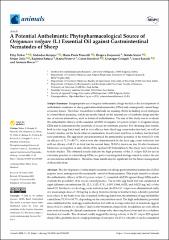A Potential Anthelmintic Phytopharmacological Source of Origanum vulgare (L.) Essential Oil against Gastrointestinal Nematodes of Sheep

View/
Date
2023-01Author
Štrbac, Filip
Krnjajić, Slobodan
Maurelli, Maria Paola
Stojanović, Dragica
Simin, Nataša
Orčić, Dejan
Ratajac, Radomir
Petrović, Kosta
Knežević, Goran
Cringoli, Giuseppe
Rinaldi, Laura
Bosco, Antonio
Metadata
Show full item recordAbstract
The development of anthelmintic resistance in sheep gastrointestinal nematodes (GINs)
requires novel strategies for the sustainable control of these parasites. This study aimed to evaluate
the anthelmintic efficacy of the Origanum vulgare (L.) essential oil (EO) against sheep GINs and to
evaluate the possibility of its use in control practice. The in vitro egg hatch test was conducted at
eight different concentrations (50, 12.5, 3.125, 0.781, 0.195, 0.049, 0.025, and 0.0125 mg/mL) of the
tested EO. For the in vivo fecal egg count reduction test, the EO of O. vulgare was administrated orally
at a mean single dose of 150 mg/kg to sheep from two farms in Southern Italy, whereby potential
toxic effects to the hosts were also evaluated. In the egg hatch test, the inhibition of egg hatchability
varied from 71.3% to 93.7%, depending on the concentration used. The high anthelmintic potential
was confirmed in the fecal egg count reduction test with an average reduction of nematode eggs in
feces of 43.2% and 60.1% on days 7 and 14 after treatment, respectively. In addition, no toxic effects
were noticed during the clinical examination of sheep or by observing blood count and liver or kidney
function test results. The obtained results suggest the strong activity of the O. vulgare EO against
sheep GINs, probably due to a high percentage of carvacrol (76.21%), whereby it can be considered
safe for sheep at the dose tested in vivo. Therefore, it is suitable for use in veterinary practice as a
part of an integrated strategy for the control of sheep GINs.
